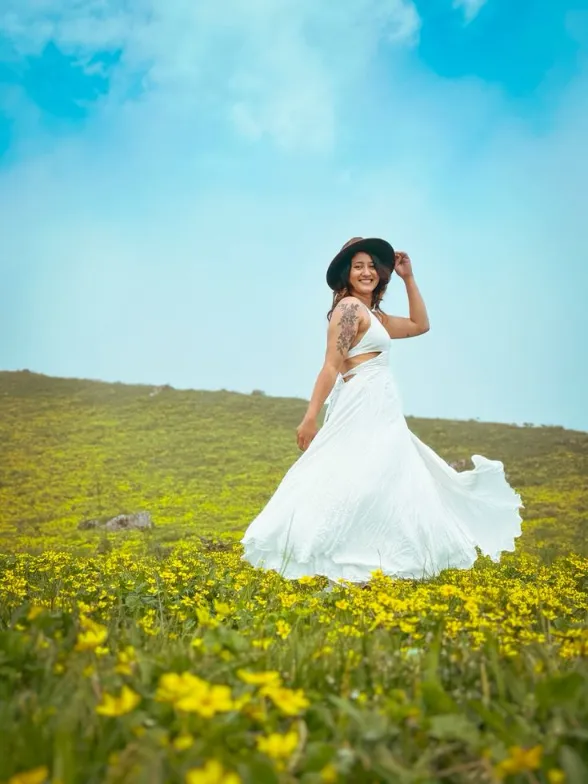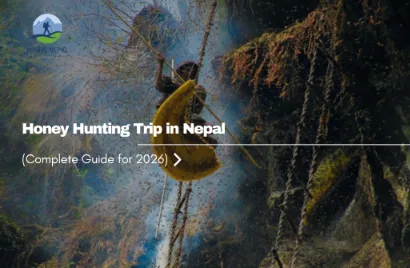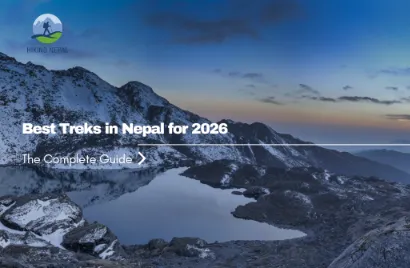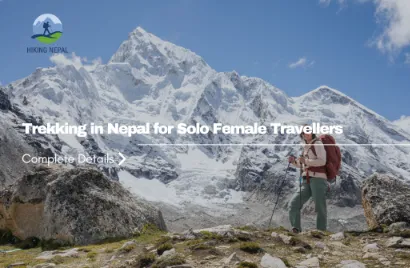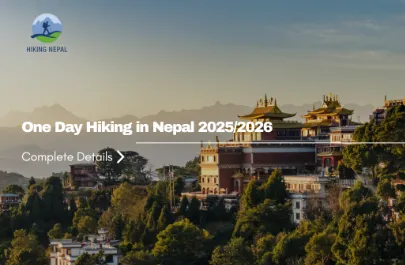Trekking in Nepal is more than just a walk through the mountains—it’s a journey into the heart of the Himalayas. From the towering peaks of Everest and Annapurna to the remote trails of Langtang and Manaslu, each trek is an adventure of a lifetime. But as magical as it sounds, trekking in Nepal also comes with its own set of challenges—altitude, unpredictable weather, rugged terrain, and cultural etiquette.
To help you make the most of your experience, we’ve compiled 40+ essential tips covering altitude safety, packing, food, hygiene, money-saving strategies, and more. Whether you're a first-time trekker or a seasoned hiker, these insider tips will help you trek smart, safe, and stress-free.
Tips for Altitude & Fitness
Trekking in Nepal isn’t just about walking long distances; it’s about preparing your body and mind for the altitude, terrain, and physical demands. The Himalayas are no joke—altitude sickness can affect even the fittest trekkers. To ensure a smooth trek, you need to focus on proper training, gradual acclimatization, and hydration. Here are some key tips to keep you strong and steady on the trail.
- Don’t underestimate altitude – It’s not about how fit you are; altitude sickness doesn’t discriminate. Acclimatize properly, drink plenty of water, and take it slow.
- Workout before your trek – You don’t need to be a marathon runner, but cardio, leg strength, and endurance training will help.
- Wear your trekking boots – Nothing ruins a trek faster than blisters. Test your boots on short hikes before bringing them to the Himalayas.
- Make your dates flexible – Weather delays happen. Add a couple of extra days at the end of your trek so you won’t miss your flight home.
- Read the fine print – Check the booking conditions before signing up for a trek. Helicopter evacuations and refunds aren’t always guaranteed.
- Prepare for all weather – The Himalayas don’t care about the forecast. Expect sun, rain, snow, and wind—all on the same day.
- Expect flight delays – If you’re flying to Lukla or Jomsom, don’t be surprised if your flight gets delayed due to bad weather. Bring a book (or two).
- Carry a pillowcase – Teahouses provide pillows, but hygiene can be questionable. Slip on your pillowcase for a clean, comfy sleep.
- Hire a professional trekking agency – Local knowledge = better experience. Plus, permits, routes, and logistics are a lot easier with pros handling them.
Money-Saving Tips: Trek Smart, Spend Less
Nepal is a budget-friendly destination, but trekking costs can quickly add up if you’re not careful. Flights, permits, gear, guides, food, and accommodation—all these expenses can strain your wallet if you’re not prepared. But don’t worry, there are plenty of ways to save money without compromising your experience. Follow these smart budget tips to make your trek affordable yet unforgettable.
- Buy your gear in Kathmandu – Thamel is a goldmine for trekking gear—whether you need brand-new or budget-friendly knockoffs.
- Bring a solar charger – Electricity costs extra in teahouses. A solar charger saves money and keeps your gadgets alive.
- Get insurance with helicopter evacuation – If you need an emergency airlift, this will save you thousands of dollars.

Food & Drinks: Eat Right, Trek Strong
What you eat and drink on the trek matters more than you think. High-altitude trekking burns thousands of calories per day, and your body needs the right fuel to keep going. However, not all food is safe or recommended at high altitudes. Want to stay energized and avoid stomach troubles? Follow these essential food and drink tips for a healthy and hassle-free trek.
- Pack your favorite snacks – Because after days of dal bhat, you’ll dream of a chocolate bar or energy gel.
- Bring a thermos – Keeps tea, coffee, or hot water warm in freezing temperatures.
- Carry water purifiers – Bottled water is expensive (and bad for the environment). Use water purification tablets or a filter.
- Eat enough – You’ll be burning thousands of calories daily. Eat big portions, even if you’re not super hungry.
- Avoid non-veg items – Meat isn’t fresh at high altitudes (it’s carried up on yaks or mules for days). Stick to vegetarian options.
- Skip alcohol and smoking – Both dehydrate you and make altitude sickness worse. Save the celebration for after the trek.
- Consider taking multivitamins – Vitamin C, B Complex, and garlic tablets can help your body cope with the demands of trekking.
- Be mindful of food in Kathmandu – Street food is delicious but risky. A bad stomach before your trek? Not worth it.
Sanitation Tips: Stay Fresh (or as Fresh as Possible)
Let’s be real—staying clean while trekking is a challenge. Showers are rare, toilets are often basic, and hygiene standards in remote villages aren’t the same as in cities. But that doesn’t mean you have to feel dirty or uncomfortable throughout the trek. With the right preparation and a few simple tricks, you can stay as fresh and hygienic as possible in the Himalayas.
- Squat toilets are common – Western-style toilets? Rare at higher altitudes. Be ready to squat.
- Bring toilet paper & wipes – Toilet paper isn’t free in teahouses. Carry your own.
- Use dry bags – Keeps toiletries, electronics, and clothes safe from rain and spills.
- Carry dry shampoo & soap – Showers are rare and freezing cold. Dry shampoo is a lifesaver.
- Braid long hair – Keeps it from getting tangled, dirty, or frozen in the wind.
Medical Safety: Health First, Goals Second
Your health should always be the top priority when trekking in Nepal. The mountains are beautiful but unforgiving, and medical facilities are limited once you leave the cities. Altitude sickness, dehydration, injuries, and infections are real risks—but with the right knowledge and precautions, you can avoid serious health issues. Here are the most important medical safety tips to keep you healthy and strong throughout your trek.
- Consult a doctor before your trek – Altitude medication, vaccines, and general health checks are essential.
- Pack a solid first-aid kit – Blister patches, painkillers, altitude meds, and antiseptics should be in your bag.
- Know your headaches – A mild headache? Normal at altitude. A pounding headache with dizziness and nausea? Get down fast.
- Protect yourself from sunburn – The Himalayan sun is brutal. Wear sunscreen, sunglasses, and a hat.
- Understand altitude sickness – It can hit anyone. Acclimatize, stay hydrated, and never ignore symptoms.
- Plan acclimatization days – The best way to avoid altitude sickness is to take rest days at key points.
- Trek with the best guides – Local guides know the mountains better than Google Maps.
- Understand your route – Get a detailed briefing from professionals before hitting the trail.
- Don’t trek alone – The mountains are unpredictable. Travel with a group or guide.
- Bring a head torch – Power cuts happen. Night hikes or late-night bathroom trips? You’ll need it.
- Trek at a slow, steady pace – Rushing = altitude sickness and injuries.
- Prepare mentally – Trekking in Nepal is physically and mentally challenging. Keep a positive attitude.

Other Must-Know Trekking Tips
Trekking isn’t just about walking from one point to another—it’s about experiencing the culture, the people, and the adventure in the best way possible. From understanding local customs to packing wisely and choosing the best time to trek, these final tips will help you make the most of your Himalayan journey.
- ATMs are unreliable—carry cash – The higher you go, the fewer ATMs you’ll find. Bring enough rupees.
- Have alternative plans – If your trek gets canceled, consider shorter treks like Poon Hill or Langtang.
- Carry extra money – You’ll need it for hot showers, charging devices, or extra food.
- Relax and enjoy the trek – Not every day will be easy, but the experience is worth it.
- Talk with the locals – Sherpas and villagers have amazing stories and knowledge.
- Pick the right season – Spring (March-May) and Autumn (Sept-Nov) are the best times to trek.
- Don’t fear suspension bridges – They look scary but are stronger than they seem.
- Respect local culture – Follow customs, greet properly, and ask before taking photos.
FAQs for trekking in Nepal
1. What is the best time to trek in Nepal?
The best seasons for trekking in Nepal are spring (March-May) and autumn (September–November) when the weather is stable, the skies are clear, and the views are breathtaking. Winter (December–February) is also an option for lower-altitude treks, while summer (June–August) brings monsoon rains, making trails slippery.
2. Do I need a trekking permit?
Yes, most trekking routes require permits. The common ones include the TIMS (Trekkers' Information Management System) card and national park/conservation area permits. Restricted regions like Upper Mustang and Manaslu require special permits.
3. How difficult is trekking in Nepal?
The difficulty depends on the trek. Everest Base Camp and Annapurna Circuit are moderate to difficult, while Ghorepani Poon Hill and Langtang Valley are easier. Altitude, terrain, and weather conditions play a big role in determining the challenge level.
4. How can I prevent altitude sickness?
Acclimatization is key! Take rest days, stay hydrated, ascend gradually, and avoid alcohol. If symptoms like headaches, nausea, or dizziness appear, descend immediately and seek medical help.
5. What should I pack for a trek in Nepal?
Essentials include good trekking boots, layered clothing, a down jacket, a sleeping bag, a water purifier, sunscreen, and basic medicines. Packing light while carrying the necessary gear is crucial for a comfortable trek.
6. Do I need travel insurance for trekking?
Yes! Make sure your insurance covers high-altitude trekking, emergency evacuations, and medical expenses. Helicopter rescues can be expensive, so insurance is a must.
7. Can I trek solo in Nepal?
Yes, but hiring a guide or porter is recommended, especially for high-altitude or remote treks. Some areas, like Manaslu and Upper Mustang, require a guide by law.
8. Is Wi-Fi and charging available on the trek?
Yes, most teahouses offer Wi-Fi and charging for an additional fee. However, connections can be slow, and power sources may be limited. Carrying a power bank or solar charger is a good idea.
9. What is the accommodation like during treks?
Trekkers stay in teahouses, which offer basic lodging with twin beds, blankets, and simple meals. In popular routes like Everest and Annapurna, some teahouses provide hot showers and heated dining rooms for an extra cost.
10. How much does trekking in Nepal cost?
The cost depends on the route, duration, permits, and whether you hire guides/porters. A budget trek can start at $30–$50 per day, while more luxurious options cost more. Restricted areas have higher permit fees.
Final Thoughts
Trekking in Nepal is more than just an adventure—it’s an experience that stays with you forever. From the breathtaking trails of the Everest and Annapurna regions to the remote beauty of Langtang and Manaslu, every trek is a journey of discovery. But the Himalayas are as challenging as they are beautiful, and the right preparation can make all the difference. At Hiking Nepal, we’ve guided countless trekkers through these stunning landscapes, ensuring they have a safe, comfortable, and unforgettable journey. Need expert advice or a trusted guide? Reach out to us at [email protected] or call us at +977 9802342080—we’ll help you make your dream trek a reality.

